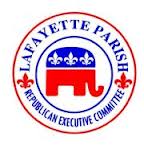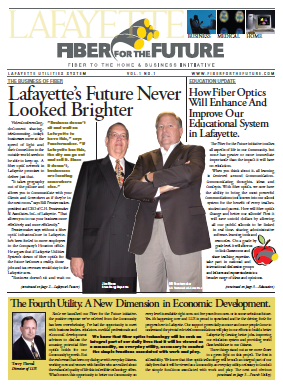
Fast, affordable Internet access for all.

We, the members of the Lafayette Democratic Parish Executive Committee, believe the project will enhance businesses, enrich our lives, and prepare our children for the future. With proper planning, future generations will see profits generated by this project stay in this community and improve businesses and lives for generations to come. Improving local communities has been the traditional purpose of the Democratic Party. With that in mind, we commend City-Parish President Joey Durel for his bold initiative to make this plan a success.A few weeks later, the Lafayette Republican Party endorsed the network [pdf] as well:

...
We have covered developments in the town of Indianola, Iowa, where the community decided to build their own network in 1998. The original purpose for investment was to use the network to enhance public safety and increase efficiency with SCADA applications. In 2005, however, the network began offering telecommunications services to local businesses. As of October, Indianola Municipal Utilities (IMU) began offering fiber-to-the-home to residents as it gradually begins expanding the use of its fiber asset.
You can now hear firsthand about the network, its history, and how the municipal utility navigated the journey to its next-generation open access network. Craig Settles interviewed Todd Kielkopf, General Manager of IMU, in an August Gigabit Nation podcast. The two discuss IMU's evolution since 1998. They also talked about the unique advantages that exist when a community considering network infrastructure investment already has a municipal utility in place.
Kielkopf tells how the driving factor for the fiber installation was to allow easier management and communication between utilities. When a 1990 franchise agreement with MediaCom was about to expire, the city investigated options. Hopes were that that the city could build a fiber network and MediaCom would offer services over that network, but that vision was never embraced by MediaCom.
Iowa law allowed the city to hold a referendum asking residents for permission to provide telecommunications services through the municipal utility's network. The referendum passed and they created a five year financial plan. Financing was with taxable and tax exempt bonds. The electric utility would build and own the network and a new telecommunications utility would license to a private partner that would offer retail services. Now, IMU and Mahaska Communication Group (MCG) have an agreement whereby MCG provides retail services over the network. While the agreement is not exclusive, no other providers currently use the network.

Recently, we let you know about the situation in Siloam Springs, Arkansas, population 15,039. The town is now investigating the possibility of building their own fiber network. They have had several community meetings and a "vote of the people" is set for May 22, 2012.
Pamela Hill is investigating the twists and turrns in a series of articles about the vote. In one of her articles, Hill looked into another Arkansas community, Paragould, home of the annual "Loose Caboose" Festival. This community, located in the northeast corner of the state, has successfully operated their own cable network since 1991. Unlike Siloam Springs, the people of Paragould weren't focused first on generating new revenue for the local government, they just wanted to be able to watch tv for a reasonable price.
Back in 1986, Cablevision was the only provider in Paragould. Hill spoke with Rhonda Davis, CFO of Paragould Light, Water & Cable:
"The public wasn’t happy with Cablevision’s service or rates,” Davis said. “We took it to a public vote and did it.”
Prior to Paragould's decision to build their own network, the City had a nonexclusive franchise agreement with Cablevision. The town was dissatisfied by the service they received and, in 1986, Paragould voters approved an ordinance authorizing the Paragould Light and Water to construct and operate a municipal cable system. Three years later, there was a referendum that authorized the city to issue a little over $3 million in municipal bonds to finance the system.
That same month, Cablevision filed suit alleging antitrust violations, breach of contract, and infringement of first and fourteenth amendment rights. The district court dismissed the antitrust and constitutional claims and Cablevision appealed unsuccessfully. The case attracted attention from lawyers and business scholars across the country.
Not long ago, we told you about Leverett, Massachusetts, the small town of 1,851, that has been discussing the possibility of building a community network. Residents and businesses currently use a combination of satellite, dial-up, DSL, and wireless, and about 6% of the population has no Internet access at all. People are tired of lost opportunities in a town strategically situated near several colleges. The town just approved the proposal to invest in a municipal network.
Last Saturday, April 28th, the measure to build the network was approved at Leverett's Annual Town Meeting. The needed two-thirds vote came easily, with 306-33 in favor, at the packed meeting at the Leverett Elementary School auditorium. Enthusiasm and expectations are high. From a Fran Ryan article in the Gazettenet.com:
For many, the lack of adequate Internet access has created problems with work, school and even the ability to sell their homes.
"Right now we have hopeless telephone service, useless cellphone service, and no internet service," said resident Raymond Bradley. "This will completely change our lives,"
The current plan is to borrow $3.6 million to create a fiber-optic network that will connect every home and provide triple play services across town. As you may recall from our earlier article, Internet access is only part of the problem - Leverett has had longstanding difficulties with telephone service due to decaying infrastructure. The situation is so bad, the State Department of Communications ordered Verizon to make repairs in over 100 towns in western Massachusetts. With this vote, however, Leverett has decided to take control of its own fate.
Leverett received a $40,000.00 planning grant from the Massachussetts Broadband Institute and benefited from the expertise and efforts of the Wired West group. Leverett's last mile project will connect with MBI's middle mile project.
According to the Leverett Broadband Committee, the investment will pay off rather quickly. This from an April 18th Ben Storrow GazetteNet.com article:
David Cameron, city administrator, said the proposal is not so much about dissatisfaction with current providers as it is about finding new revenue for the city. Cameron said revenue from electric services has been a key source of funding for various projects and necessities for the city. That “enterprise” fund is getting smaller, Cameron said, and an alternative funding source is needed. “We have done a good job managing accounts, building a reserve,” Cameron said. “We want to keep building on the programs we have. It takes money and funds to do that.” City officials discussed the issue for the last 18 months and decided to put it to a referendum. Voters will decide the issue May 22.That is a fairly unique reason. Most communities want to build these networks to encourage economic development and other indirect benefits to the community. Given the challenge of building and operating networks, few set a primary goal of boosting city revenue.

If approved by voters, the city plans to spend $8.3 million to install 100 miles of fiber optic cable directly to homes and businesses. The city should be able to repay the debt in 12 years, if things go according to a feasibility study presented to the city’s board of directors in January.
Soeffker, who farms with her husband in rural Sibley County, said the dish receiver they must use works fine in good weather but balks during heavy rain and snowstorms. Meantime, her husband struggles with a lagging Internet speed of .6 megabits a second that falls short of meeting his business needs when he’s selling commodities.The committee organizing the network set a goal for demonstrating the interest of something like 50% of the population in the target area. There has been some confusion as to exactly how many they should have before committing to the project but with just two mass mailings, they have received nearly 3,000 positive responses (of the over 8000 households that could be served). This is a very strong response. To keep the public informed, they have had numerous public meetings in each of the communities that will be involved. To be as open as possible, they would often have three meetings in a town per day -- a morning, afternoon, and evening meeting to accomodate everyone's schedule. As this project moves forward, no one can claim the group has been anything but open with the plan. On January 19, they had a major meeting with over 100 people attending, including many elected officials from the towns. For over two and a half hours, they had five presentations and numerous questions.
 The newsletter also has a word from the Mayor (the inimitable Joey Durel) and quotes the Greater Lafayette Chamber of Commerce Broadband Policy. Finally, it also explains why the Lafayette Utilities System should build the network and cites successes from BVU in Bristol, Virginia.
Groups that are looking for strategies or a template for a web presence should check out Lafayette Coming Together. This was the organizing site they used in building support for the network, as a complement to Lafayette Pro Fiber. Unfortunately, the Fiber Film Festival web page no longer exists, but the most popular video (Slick Sam Slade) is still around - and embedded below.
An old episode examining the arguments around the network is still viewable (for Windows users) via the Louisiana Public Broadcasting archives -- look for episode #2844.
The newsletter also has a word from the Mayor (the inimitable Joey Durel) and quotes the Greater Lafayette Chamber of Commerce Broadband Policy. Finally, it also explains why the Lafayette Utilities System should build the network and cites successes from BVU in Bristol, Virginia.
Groups that are looking for strategies or a template for a web presence should check out Lafayette Coming Together. This was the organizing site they used in building support for the network, as a complement to Lafayette Pro Fiber. Unfortunately, the Fiber Film Festival web page no longer exists, but the most popular video (Slick Sam Slade) is still around - and embedded below.
An old episode examining the arguments around the network is still viewable (for Windows users) via the Louisiana Public Broadcasting archives -- look for episode #2844.